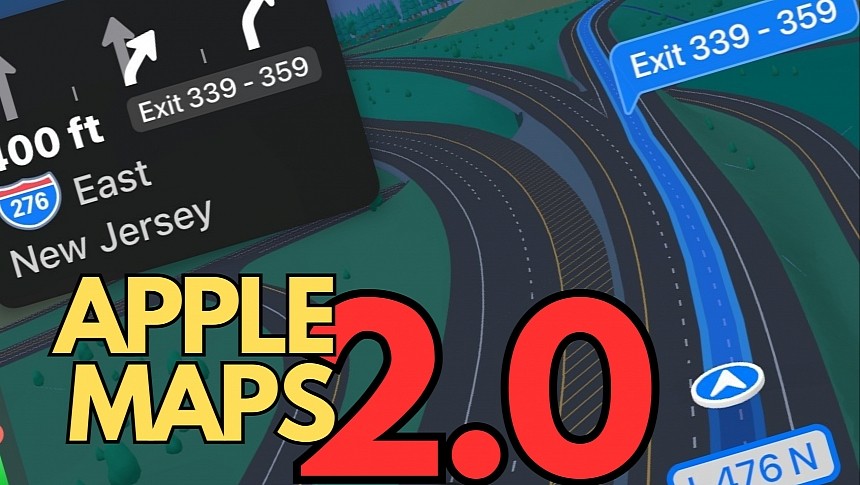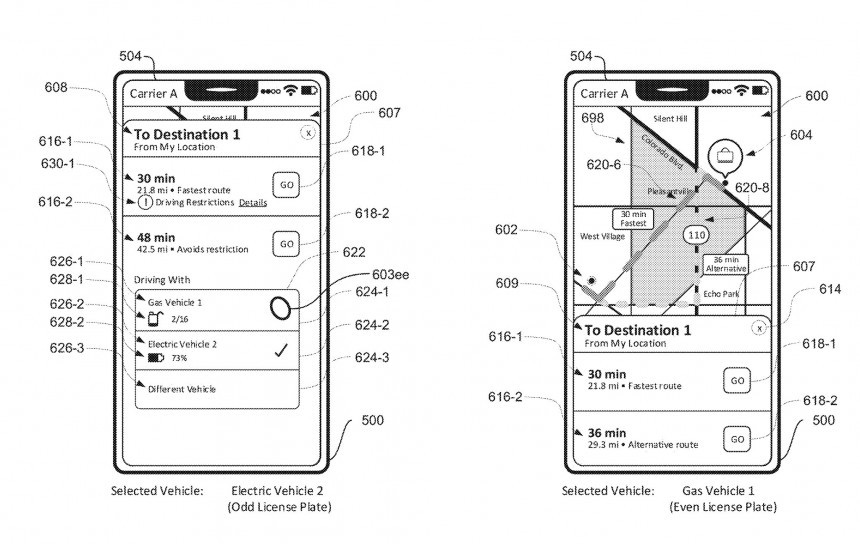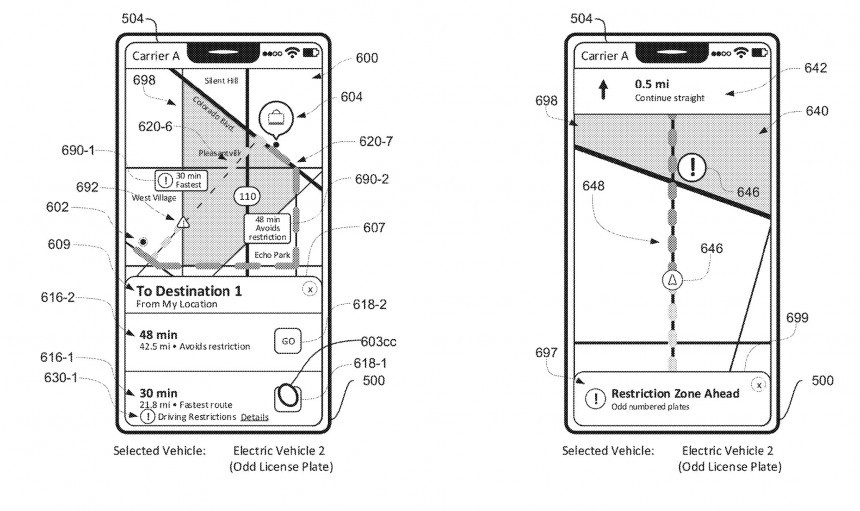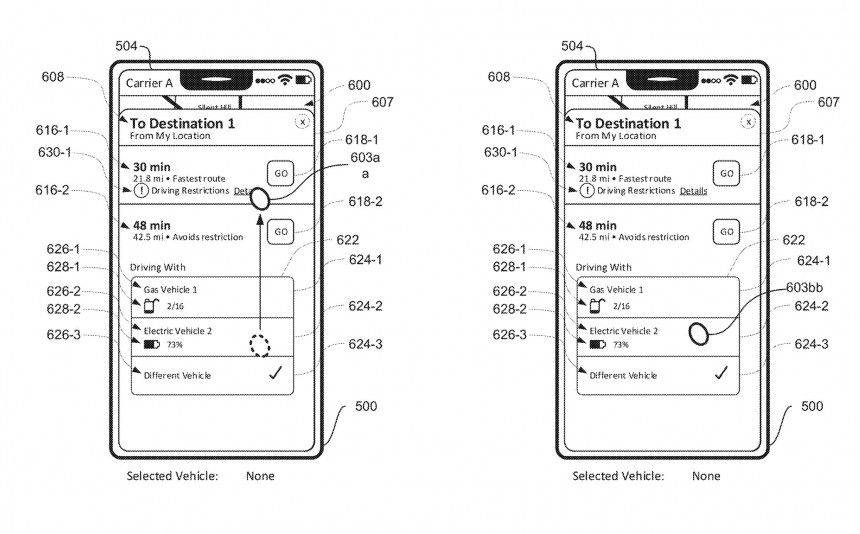Apple is working around the clock on a massive Apple Maps transformation, with the Detailed City Experience spearheading the push to provide users with detailed maps, upgraded navigation, and Look Around support for street-level imagery.
However, the iPhone maker is eyeing a complete overhaul of the mapping platform, with its long-term strategy comprising new-generation features to support deeper vehicle integration for optimized routing.
Some of Apple's ideas have recently been revealed in a patent covering "user interfaces for customized navigation routes," providing us with a very early glimpse into what could eventually become Apple Maps 2.0.
Here are the key tidbits from the patent, and you can find the complete application in the box after the jump if you're also interested in the technical details.
The new Apple Maps would completely focus on vehicle integration regardless of the powertrain (conventional engines or electric motors).
Apple wants Apple Maps to provide customized routing based on the engine type. Assuming the application can read the current mileage based on how much gas you still have in the tank or the battery charge, Apple wants Apple Maps to look for routes that include stops for filling the tank or charging the battery.
This idea isn't new, and Google Maps already offers such capabilities on Android Automotive. Apple Maps can also check the battery range and suggest charging stops in vehicles where EV routing is available, thanks to deeper vehicle integration.
However, the Cupertino-based tech giant envisions a complete overhaul of this feature. Renderings included in the patent application indicate that users will be allowed to configure vehicle profiles, sometimes imported from companion apps developed by carmakers, to provide optimized routing.
It'll support gas-powered and electric vehicles, and depending on the selected profile, it can generate custom routes. For example, Apple Maps can look for more efficient routes when driving an EV or avoid regions where petrol vehicles might have to pay special taxes.
Additionally, Apple Maps could check the vehicle range and look for routes that include fuel stations or charging stations (depending on the selected profile) when it estimates that a refill or recharge is required to reach the destination.
Apple Maps can offer several routes, including the fastest and one alternative, with the latter typically generated to avoid potential fees or restrictions.
Apple explains that integration with carmaker apps will be a key feature of the next-generation Apple Maps.
The idea is simple and has already been implemented on certain Porsche models via the My Porsche app.
The carmaker app feeds data into Apple Maps, providing the navigation app with all the information it needs for customized routing. It can help refine the vehicle profiles, sharing engine information, fuel consumption data, mileage, range, and battery level in the case of electric vehicles.
Additionally, users would be allowed to configure the license plate in case their routes go through lotions with restrictions based on the license plate. Apple Maps would show a warning when such restrictions are active and also offer an alternative route to help the driver avoid them.
Apple wants to transform Apple Maps into a vehicle hub, especially for users who own more than a car.
The application can display the mileage and the fuel level or battery charge of every vehicle on the home screen so the driver can decide what car to drive before leaving the house. They can configure the route, see how many stops (if any) are required for refilling or recharging, and make an informed decision on the vehicle.
The planning phase is significantly upgraded, with Apple Maps continuously monitoring each vehicle, even during a trip. For example, if the application estimates that an EV needs approximately 50% more battery to reach a destination, it can suggest a charging stop, monitor the battery during the charging process, and offer a notification when the battery charge allows the driver to reach the destination.
It can also provide ETAs for the battery charging based on integration with the carmaker's app.
The connection to the vehicle is integral to the new Apple Maps, and the features could eventually be available on CarPlay, too. The new-generation CarPlay, which has already been confirmed on Aston Martin and Porsche models due in 2024, could access more vehicle apps by connecting to OEM applications – Apple Maps already does this on CarPlay on the Porsche Taycan, so a similar approach could be used for additional models scheduled to launch next year.
The new CarPlay experience is projected to launch in 2024, and while all these ideas are still in the patent stage, I wouldn't be surprised to see Apple trying to bring them to mass production. All these features look like a natural upgrade for navigation capabilities, not only for Apple Maps but also for CarPlay, whose major transformation is just around the corner.
Some of Apple's ideas have recently been revealed in a patent covering "user interfaces for customized navigation routes," providing us with a very early glimpse into what could eventually become Apple Maps 2.0.
Here are the key tidbits from the patent, and you can find the complete application in the box after the jump if you're also interested in the technical details.
Vehicle profiles
Apple wants Apple Maps to provide customized routing based on the engine type. Assuming the application can read the current mileage based on how much gas you still have in the tank or the battery charge, Apple wants Apple Maps to look for routes that include stops for filling the tank or charging the battery.
This idea isn't new, and Google Maps already offers such capabilities on Android Automotive. Apple Maps can also check the battery range and suggest charging stops in vehicles where EV routing is available, thanks to deeper vehicle integration.
However, the Cupertino-based tech giant envisions a complete overhaul of this feature. Renderings included in the patent application indicate that users will be allowed to configure vehicle profiles, sometimes imported from companion apps developed by carmakers, to provide optimized routing.
It'll support gas-powered and electric vehicles, and depending on the selected profile, it can generate custom routes. For example, Apple Maps can look for more efficient routes when driving an EV or avoid regions where petrol vehicles might have to pay special taxes.
Additionally, Apple Maps could check the vehicle range and look for routes that include fuel stations or charging stations (depending on the selected profile) when it estimates that a refill or recharge is required to reach the destination.
Apple Maps can offer several routes, including the fastest and one alternative, with the latter typically generated to avoid potential fees or restrictions.
Integration with carmaker apps
The idea is simple and has already been implemented on certain Porsche models via the My Porsche app.
The carmaker app feeds data into Apple Maps, providing the navigation app with all the information it needs for customized routing. It can help refine the vehicle profiles, sharing engine information, fuel consumption data, mileage, range, and battery level in the case of electric vehicles.
Additionally, users would be allowed to configure the license plate in case their routes go through lotions with restrictions based on the license plate. Apple Maps would show a warning when such restrictions are active and also offer an alternative route to help the driver avoid them.
Fully featured vehicle navigation hub
The application can display the mileage and the fuel level or battery charge of every vehicle on the home screen so the driver can decide what car to drive before leaving the house. They can configure the route, see how many stops (if any) are required for refilling or recharging, and make an informed decision on the vehicle.
The planning phase is significantly upgraded, with Apple Maps continuously monitoring each vehicle, even during a trip. For example, if the application estimates that an EV needs approximately 50% more battery to reach a destination, it can suggest a charging stop, monitor the battery during the charging process, and offer a notification when the battery charge allows the driver to reach the destination.
It can also provide ETAs for the battery charging based on integration with the carmaker's app.
The connection to the vehicle is integral to the new Apple Maps, and the features could eventually be available on CarPlay, too. The new-generation CarPlay, which has already been confirmed on Aston Martin and Porsche models due in 2024, could access more vehicle apps by connecting to OEM applications – Apple Maps already does this on CarPlay on the Porsche Taycan, so a similar approach could be used for additional models scheduled to launch next year.
The new CarPlay experience is projected to launch in 2024, and while all these ideas are still in the patent stage, I wouldn't be surprised to see Apple trying to bring them to mass production. All these features look like a natural upgrade for navigation capabilities, not only for Apple Maps but also for CarPlay, whose major transformation is just around the corner.




















